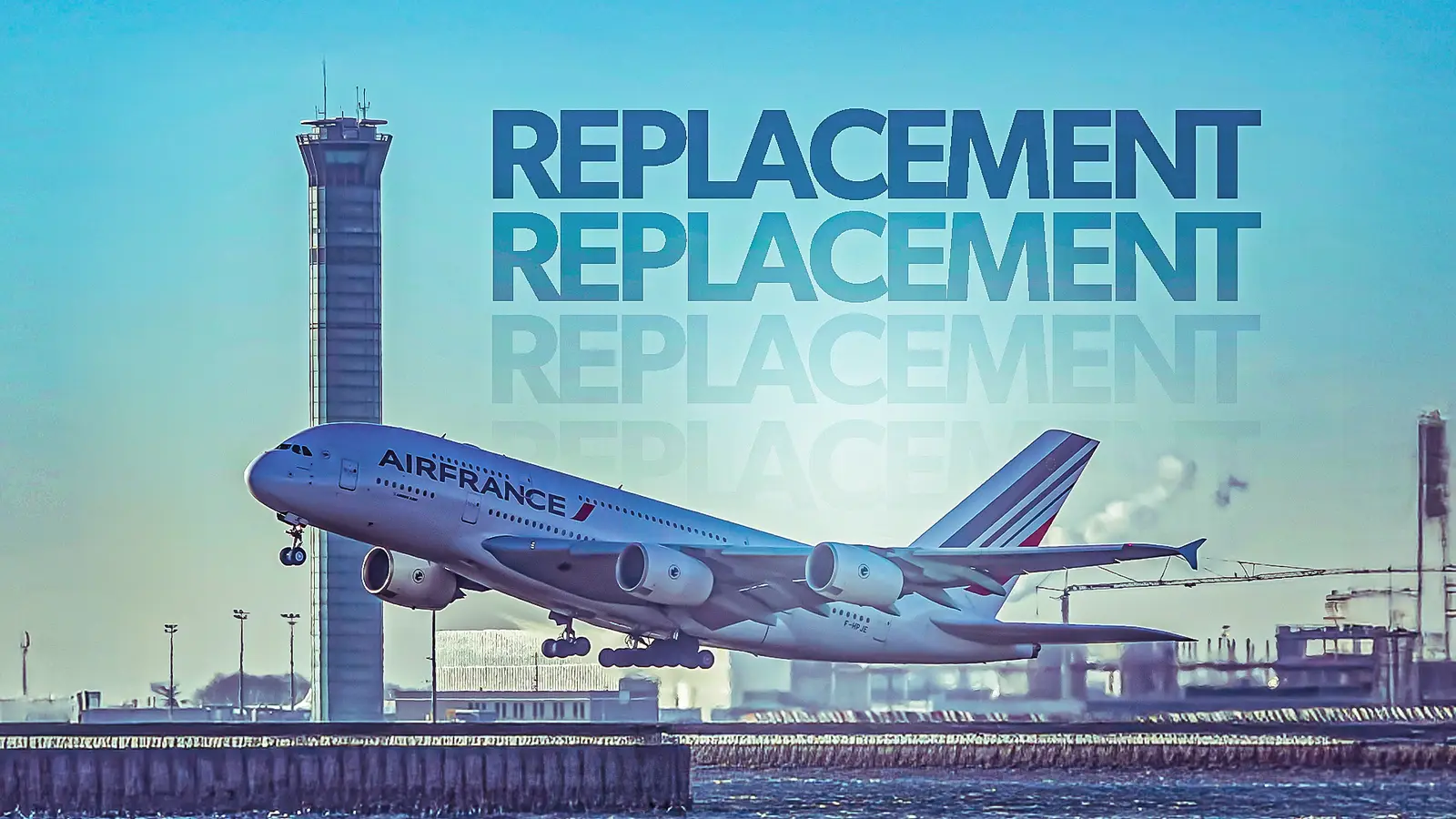Copyright Simple Flying

Around twenty years after the Airbus A380 rewrote what it meant for an aircraft to be "large" in the world of commercial aviation, the industry's center of gravity has since shifted towards advanced twin-engine widebodies, aircraft that offer exceptional capabilities, especially when it comes to fuel efficiency. Airlines still value the Airbus A380's crowd-pleasing cabin and ability to deliver capacity during peak hours, all while unit economics and the network flexibility of the Airbus A350, the Boeing 787 Dreamliner, and the Boeing 777X continue to define the era of Airbus A380 replacement. The Boeing 787's composite structure and advanced systems reduce overall fuel burn by around 25% compared to earlier-generation aircraft, allowing carriers to stitch together long, profitable, thinner routes that the Airbus A380 would overserve. The Airbus A350 family extends that efficiency to the 300-410-seat bracket, with the larger Airbus A350-1000 delivering Boeing 777-300ER-class range and payload at materially lower trip and overall seat costs. At the very top, the Boeing 777X promises a 400-seat scale with a new carbon-fiber wing and General Electric GE9X engines, all poised to take over the densest trunk routes that once justified Airbus A380 service. However, first deliveries are now forecast for 2027. Emirates remains the world's largest Airbus A380 operator, and it is hedging its future with large orders for the Boeing 777X and the Airbus A350. A Brief Overview Of The Airbus A380 And The Role It Serves Airbus launched the Airbus A380 with the intention of using the aircraft to topple the Boeing 747's hub-and-spoke dominance by moving huge amounts of volume through congested megahubs. The aircraft's engineering is undeniably bold, featuring a full-length double-deck configuration, four high-thrust engines, and a cabin that could seat 500–600 passengers in typical three-class configurations, with extraordinary quietness and space. After a 2005 first flight and subsequent entry into service with Singapore Airlines, the manufacturer delivered 251 aircraft of the type to 14 customers before winding down production in 2021, when the final jet went to Emirates. The aircraft's roughly 8,000-nautical-mile range (14,800 km) allows airlines to link Europe and Asia, as well as other transpacific and transatlantic hubs, efficiently while offering signature products, including suites, onboard bars, and showers. However, the market never scaled to the jet's sales forecasts. The Airbus A380's economics required consistent high load factors at slot-constrained airports, as its maintenance costs and four-engine fuel burn made it extremely expensive to operate. Fuel prices continued to rise as long-range twin-engine aircraft matured, all while airlines found greater profit in spreading capacity across multiple frequencies. Orders continued to slow, even as secondary operators exited and resale values remained relatively thin. The pandemic appeared to close the book, but as demand snapped back and hubs began to clog again, several carriers reactivated stored Airbus A380s to plug capacity gaps. At the same time, the long-term industry pivot continues to favor flexible and efficient twin-engine aircraft. A Look At Airbus A380 Operations Today Despite production of the aircraft ending, the Airbus A380 remains very much in service today. About a dozen airlines still keep the type in active service, with primary customer Emirates operating more than 100 airframes, more than half of the active global fleet. Emirates plans on keeping the jet in service well into the 2030s, demonstrating its long-standing commitment to the type, which serves as a premium workhorse for the airline. Other carriers that use the jet extensively include Singapore Airlines, British Airways, and Qantas, all of which field the double-deck aircraft to feed capacity-heavy schedules on core long-haul markets. Etihad Airways deploys the aircraft more selectively, using its premium capacity primarily on marquee routes. Qantas, for example, uses the aircraft to fly from Sydney International Airport (SYD) to Dallas/Fort Worth International Airport (DFW), Los Angeles International Airport (LAX), London Heathrow Airport (LHR), and Johannesburg's O.R. Tambo International Airport (JNB). Etihad has continued to shift capacity towards Toronto and Paris while retaining routes to London, all while Singapore Airlines uses the aircraft on isolated routes to London, Sydney, and other major destinations, depending on the season. This highlights another important modern use for the Airbus A380: adding higher capacity during peak travel months. Here are some additional details for the Airbus A380, according to data from manufacturer Airbus: These deployments highlight the Airbus A380's enduring niche, as the aircraft can operate peak-bank trunk routes at major slot-constrained hubs, where a single large wave is better than multiple smaller services. Nonetheless, fleets remain thin, and maintenance costs are relatively high, forcing Airbus A380 operators to be relatively careful with how they deploy the jet. A High-Capacity Replacement: The Boeing 777X Currently positioned as the industry's new high-capacity twin-engine aircraft, the Boeing 777X aims to fill a space that was once served by Boeing 747-400 aircraft that flew the Airbus A380's densest missions. The Boeing 777-9 pairs the General Electric GE9X's engines with a high-span, carbon-fiber wing that uses folding wingtips to fit today's gates, bringing aerodynamic gains without demanding wider aircraft stands, something essential for modern airlines. Boeing touts double-digit operating cost improvements over current large twin-engine aircraft, along with lower overall cabin altitude, quieter service volume, and improved operating efficiency. From a strategic standpoint, the Boeing 777-9 provides carriers with a 400-seat scale for slot-constrained trunk routes and peak waves, while longer-range Boeing 777-8 aircraft cover ultra-long-haul services and cargo needs. This program has been delayed. However, after pauses and added certification scrutiny, Boeing remains confident that first deliveries will occur in 2027. Some analysts remain skeptical even of this new timeline. Emirates, which is already the world's largest operator of the Boeing 777, has doubled down on orders, bringing its Boeing 777X backlog to 205 jets, signaling sustained demand at the top end of the market. When the aircraft type finally enters service, passengers can expect it to assume many of the A380's roles on higher-frequency routes where one big aircraft remains preferable to two smaller jets. Network Breadth As An Asset: The Boeing 787 Dreamliner The Boeing 787 Dreamliner is the workhorse in the era of Airbus A380 replacements. The aircraft has been built around a composite airframe that features advanced systems, enabling it to deliver roughly a 25% improvement in overall fuel burn over the aircraft it replaces. The jet's lower pressurization altitude, higher humidity, and large windows all help improve the overall passenger experience. The aircraft family offers three distinct tools for planners, including the long-legged Boeing 787-8 for thin, very long routes. It also offers the balanced Boeing 787-9, now the aircraft's most popular variant, and the higher-capacity Boeing 787-10 for dense, medium- to long-haul sectors. Typical two-class seating counts range from around 248 to 336, placing it towards the bottom end of widebody services. The type can be used to stitch together nonstop city pairs that require some capacity, but not nearly as much to fill something as large as an Airbus A380. For airlines looking to retire four-engine aircraft or high-cycle Boeing 777s, the Boeing 787 offers improved margins and greater gauge flexibility. This allows the carrier to open routes to secondary long-haul destinations while preserving premium cabin quality. The result is ultimately a steady reshaping of networks, with more point-to-point flying where demand exists and more tailored capacity on traditional hub-to-hub connections. A Capable Widebody For The 2030s: The Airbus A350 The Airbus A350 is another aircraft that can effectively replace certain elements of Airbus A380 services. The manufacturer's offering spans across two different sizes, including the Airbus A350-900 and the Airbus A350-1000. A clean-sheet design that utilizes extensive composite materials in its construction and Rolls-Royce Trent XWB engines, the Airbus A350 family targets a roughly 25% improvement in overall fuel burn and operating costs, all while driving higher carbon dioxide per seat relative to previous-generation competitors. The Airbus A350-900, which typically seats 300 to 350 passengers, covers long-range missions and ultra-long-haul stage lengths, while the A350-1000 delivers Boeing 777-300ER-class payloads at materially lower trip and overall seat costs. Airlines continue to use the Airbus A350-1000 as a replacement for aging Boeing 777-300ER fleets. Japan Airlines, for example, has begun rolling out the Airbus A350-1000 on key flagship routes as it phases out the Boeing 777-300ER. At the same time, Emirates is introducing the A350-900 to open mid-sized market routes that do not require a single Boeing 777-300ER, let alone an Airbus A380. What Are Our Bottom Line Read-Throughs From This Analysis? The challenge, at the end of the day, with replacing the Airbus A380 is simply that the jet is not replaceable. The aircraft is incredibly unique in its long-haul capabilities. It also offers a capacity that no market development program can match today. However, the aircraft is now built on a design over 20 years old, meaning these airframes are aging and will eventually need to be retired. While there is no real double-deck replacement in the works, some models can help replace the Airbus A380 and support a major global airline network. The Boeing 777X is the highest-capacity successor, but it has yet to enter service and continues to struggle with regulatory challenges. The Boeing 787 is far too small to serve as a true replacement. The Airbus A350 is extremely efficient and offers higher capacity than the Boeing 787, but it also falls short of the Airbus A380, offering only about as many seats.



